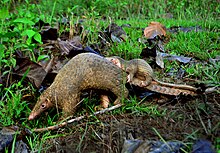| Philippine pangolin | |
|---|---|

| |
| An adult Philippine Pangolin and her pup photographed in the forests of Palawan | |
| Scientific classification | |
| Domain: | Eukaryota |
| Kingdom: | Animalia |
| Phylum: | Chordata |
| Class: | Mammalia |
| Order: | Pholidota |
| Family: | Manidae |
| Genus: | Manis |
| Subgenus: | Paramanis |
| Species: | M. culionensis
|
| Binomial name | |
| Manis culionensis (de Elera, 1895)
| |

| |
| Philippine pangolin range | |

The Philippine pangolin or Palawan pangolin (Manis culionensis), also locally known as balintong, is a pangolin species endemic to the Palawan province of the Philippines. Its habitat includes primary and secondary forests, as well as surrounding grasslands. This species is moderately common within its limited range, but is at risk due to heavy hunting because of its valued scales and meat.[3] This species is distinguished from the closely related Sunda pangolin by its smaller body-to-tail ratio, smaller scales, and a shorter head. It is listed as Critically Endangered by the IUCN, and Critically Endangered by the Palawan Council for Sustainable Development (PCSD).[4]
- ^ Schoppe, S.; Katsis, L.; Lagrada, L. (2019). "Manis culionensis". IUCN Red List of Threatened Species. 2019: e.T136497A123586862. doi:10.2305/IUCN.UK.2019-3.RLTS.T136497A123586862.en. Retrieved 19 November 2021.
- ^ "Appendices | CITES". cites.org. Retrieved 2022-01-14.
- ^ Manis culionensis Archived 2009-03-18 at the Wayback Machine in A synopsis of the mammilian fauna of the Philippine Islands. The Field Museum.
- ^ "Philippine Pangolin". Pangolinsg.org. Retrieved on 2016-06-22.
